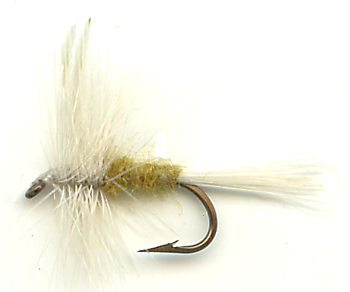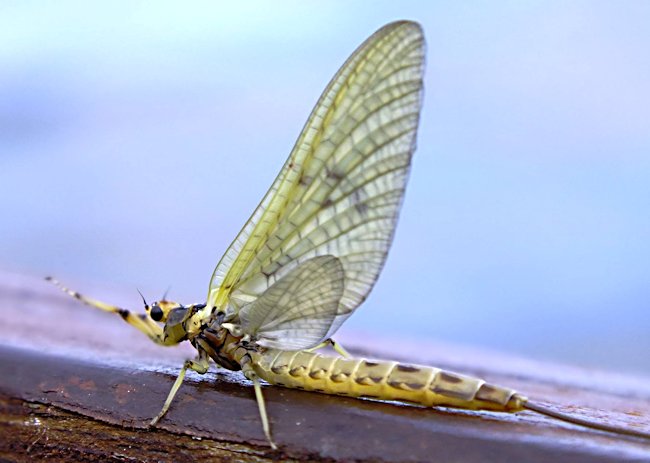The Sulfur - Sulphur Dun Dry Fly
The problems with the Sulfur / Sulphur Dun fly is that they come in many shapes, sizes and more importantly color. Some have a mustard yellow body and others a pale olive green.

DRY FLY PATTERNS. Hook size 12 14 16 18 20 24 - $US each
They are also spelt different depending on what part of the world you live in. Sulfur Dun and Sulphur Dun are both correct spellings. The insects normally start hatching in late May and on some rivers the Sulphurs hatch nearly all summer long and are a staple part of the trout's diet. Though a common Sulphur on many rivers (E. dorothea) are about a size 16 early in the season, I seldom try to imitate these small flies. I use a #12 or #14 Sulfur. The bigger size stands out among the naturals and the fish often pick that fly out.

The Sulphur / Sulfur (hatch) is the Eastern USA equivalent of the Western Pale Evening Dun. Regardless of whether you are trying to match the Sulphur Ephemerella invaria or the slightly smaller Ephemerella dorothea, the descriptions of these mayflies are similar. There are a number of species of Sulphur, but they all have yellowish, yellowish green or orange/yellow bodies. They all hatch in the evening or occasionally during mid-day hours on a cloudy day. It's typically an evening hatch, beginning anywhere from 7 to 7:30 p.m. and lasting to dark. During the Sulphur hatch, the fish are feeding freely and even if you are a beginner you will be able to catch fish during a Sulphur hatch. It doesn't mean that presentation isn't important, but being there at the right place and at the right time is probably most important, which is why it is probably such a popular hatch. It's a big hatch, a prolific hatch, and there are
Some usually finicky brown trout sometimes throw caution to the wind during the annual Sulphur hatch. In situations with little cover and slow moving water, the fish are somewhat skittish. But during the Sulfur hatch, this is one of the times of the year when you'll see the browns come out from under the banks and pretty much take these flies with abandon. The thrill about this hatch is that it is a light colored hatch that is relatively easy to see and to fish, but it doesn't mean they should always expect a dry-fly feeding frenzy either. It depends on the stream conditions.
On rivers where the water surface is broken or there is a lot of fishing pressure, you may find the trout more cautious and feed exclusively on drifting nymphs ignoring anything on the surface. If you see drifting and flying duns but no rises this is what the fish are doing and you will need to change tactics from surface dry flies to nymph fishing. The best way to choose your nymph imitation is to collect a few samples of the natural insect from the river or stream bed and match the size and color. Remember to look at them up to the light to see their true color as seen by the fish. Trout normally attack their prey from below and will look at them against the light of the bright sky. Nymphs that look black in the hand turn out to be brown or olive when the light is behind them
When the nymph is mature it rises to the surface, where the nymphal shucks split open and the duns emerge and fly off onto nearby vegetation. Soft hackle wet flies are ideal for imitating the nymph moving up the column of water to the surface. Emerger flies like Klinkhammers, Shipman's buzzer or Suspender buzzers make good choices for Sulfur nymphs hatching.
The Sulphur sits on the water surface for a few seconds after hatching to enable the blood to pump up it's wings and for them to dry. The colder the weather the longer this takes. On windy days, gusts can topple over the drifting duns and drown them. If you cannot see any rises for surface floating duns during a hatch on windy days the fish are feasting sub surface on the unlucky sinking drowned duns as well as the emerging nymphs. Try using a partridge and Yellow Soft hackled spider wet fly, Gold Ribbed Hares Ear Wet fly, or Light Cahill wet fly to imitate drowned Sulphurs depending on the local insects body color that can range from pale green, to Sulfur yellow.
If the drifting newly emerged Sulphurs have not been eaten by a fish during this vulnerable time, they fly off and hide on the surrounding vegetation. Within 24 hours the duns molt into spinners and and are ready to mate. Mating swarms are formed by the males to attract females. When a female flies into the swarm she mates with a male. The males fall onto the water spent and drown. The females return to the riverside vegetation for a short period whilst the eggs mature. When the eggs are ready the females fly out over the water, dip into the water, lay their eggs and then fall into the water spent. Try and scoop up a natural spinner floating dead in the water surface and match the body color with a parachute dry fly like a Greenwells, Tup's Indispensable or Gold Ribbed Hares Ear Parachute.
CUSTOMER'S COMMENT
Sulphurs Dun mayflies are the second major hatch on the Au Sable River and start at the end of May in the Big Waters. Typically creates some good late evening dry fly fishing. I use your sulphur Dun dry fly. It is a great pattern for this bug. John Kelly, USA
FACEBOOK READER'S COMMENT
I love a green or sulphur body...especially wonderful in PA fishing the Green Drake hatches in May on Penn's Creek or a large sulphur Drake on Spring Creek in Bellafonte in spring. Oh the trout gorge on these large delights. Monica C Bond PA, USA


Fly Fishing books

